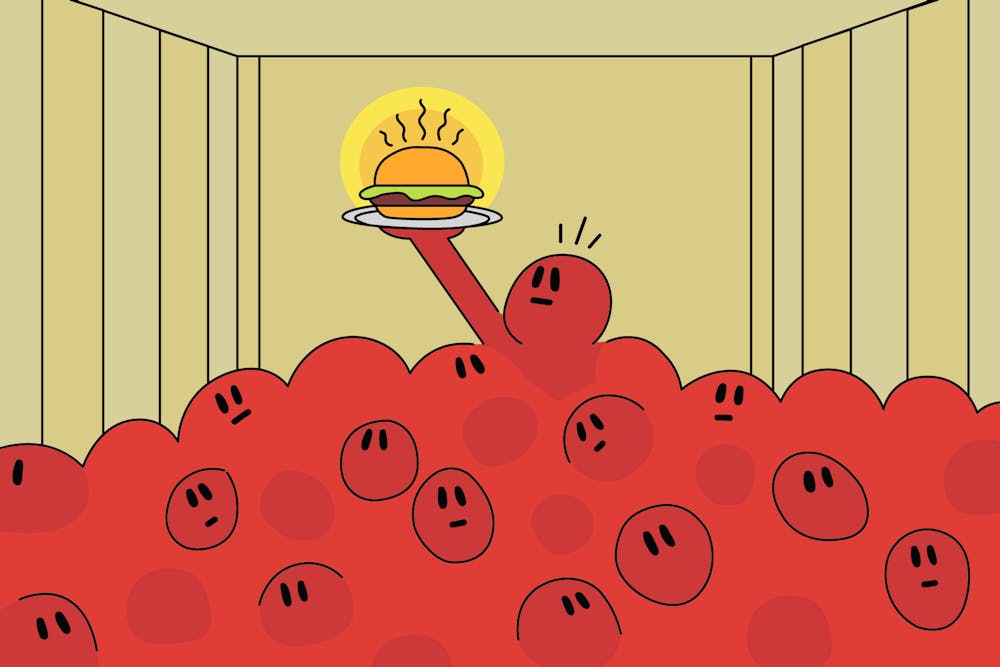It’s an almost-daily occurrence to stand in a line to get into Lenoir Dining Hall for lunch, where you will tirelessly scout out an open table, stand in another lengthy line to get food and then climb over chairs, bookbags and people to get to your seat. PLUS Swipe restaurants don’t act as a refuge with prolonged waits to get a box of food. At dinner time or after a sporting event, Chase Dining Hall consistently turns into a frenzied feeding ground. In both dining halls, promotional events like Ramsgiving or chef takeovers create the same crowded conditions.
Our dining system struggles to accommodate all the students it has to serve. Overcrowding in the dining halls is unsafe and annoying. Even more, it ruins the potential for what a meal can be — a calm break in a busy day. Meals should be times to debrief days, clear minds and fuel bodies. It is decidedly harder for a meal to function in this way when you spend 10 minutes competing in a free-for-all to find the last fork.
The dining problem has a simple solution: build another dining hall. However, insufficient space will force UNC to find creative options to increase dining options.
First, only having nine PLUS Swipe locations on North Campus, where most students eat lunch, results in winding lines at each restaurant and propels a high volume of students to the top of Lenoir. Opening additional PLUS Swipe locations could decrease the hordes of students rushing to the Chick-fil-A and top of Lenoir lines, dispersing students more evenly and taking the pressure off of current PLUS Swipe restaurants and Lenoir.
More than just broadening PLUS Swipe options, the hours of existing locations could extend to offer dinner to students. Currently, the only places to use a PLUS Swipe during dinner hours are Subway, Alpaca Peruvian Chicken, Chick-fil-A, Alpine or Bojangles, meaning most students eat dinner in a dining hall. Increasing the breadth of PLUS Swipe options at dinner could help to take the burden off of dining halls, especially Chase.
Adapting PLUS Swipe locations isn’t the only option on UNC’s menu to expand dining choices. Creating an option where students can cook for themselves would reduce the strain on current dining venues. Kitchens stocked with ingredients and cooking materials that can be entered for a meal swipe could give students an alternative to dining halls, and allow them to cook whatever they want for dinner. Multiple of these areas could be created in already existing buildings such as the Carolina Union, the top of Chase or Genome Sciences Building.
Clubs could play a part in easing the load on dining halls as well. Some clubs provide dinner for their members, however, it’s inconsistent. To decrease students in dining halls, UNC could give clubs with 200 or more members funding to cater a monthly dinner. This would provide an opportunity for community building among club members while also getting students out of the dining halls.
Similarly, first-year residence halls could be given a section of funding to host monthly, or even weekly, dinners for their residents. Much of dining hall overcrowding stems from the large and continually growing first-year class size. A solution aimed specifically at first-years would push numerous students to have dinner outside of the walls of Chase or Lenoir while helping to curb the problem for years to come.
Students shouldn’t have to worry about having enough time to eat in a dining hall if they only have a 30-minute lunch break or not being able to find a table where they can sit with six of their friends at dinner. There are many possible solutions to ensure they won’t. UNC simply has to be willing to take action to make students’ dining experiences a time to replenish, relax and connect.




